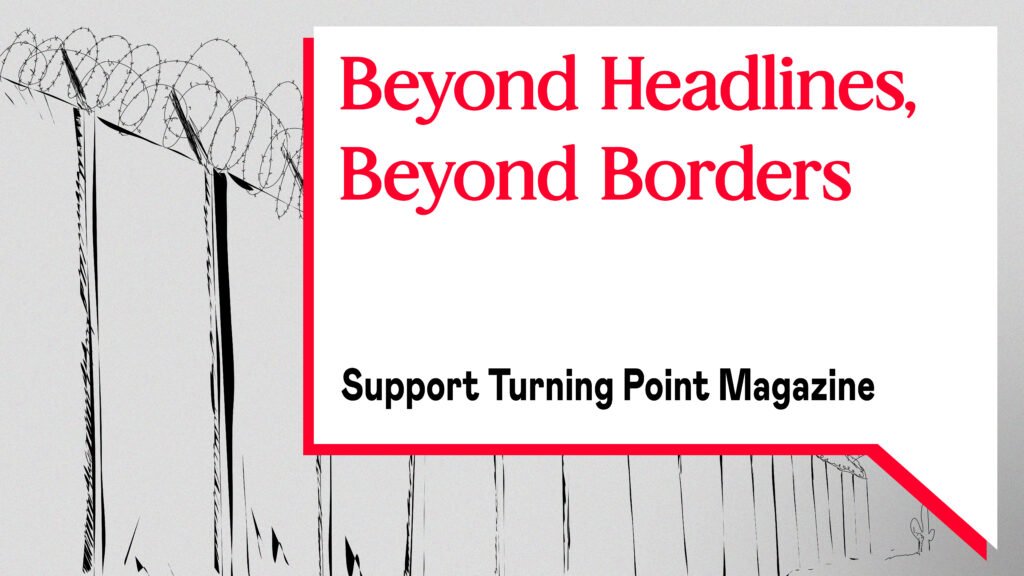Cover photo: ©Turning Point
On Monday January 20, this year, we held our regular editorial meeting online. Three of us joined from the small town of Kobane in Northern Eastern Syria, and the rest of the board from their habitual locations with decent internet connection. The meeting was short, no more than twenty minutes, due to recent bombings that had almost completely decimated the cellular network in that part of Syria. We briefly divided a few routine tasks and focused on the latest global news, weighed what is to come. Later that day, Donald Trump was to assume office as the president of USA. Like many others, we sensed that events were about to accelerate not only in the US or in the Middle East, but globally.
Indeed, that very same day, Trump issued an order to freeze all foreign aid that the US had until then channelled through USAID and the State Department. With one signature, an estimated 14 million people worldwide were destined to premature death by the end of the decade. And that was just the beginning.
Since then, a lot has happened. The idiom “yesterday’s news” for outdated, no longer relevant or interesting information is beginning to describe quite literally the news of yesterday. Hardly a day has passed without a news bomb of one kind or another. The images of Elon Musk waving a chainsaw or throwing his right arm in a distinctively Roman-ish salute—the spirit of that time—already appear as if from a slightly different era.
For us at Turning Point, this speed-up of events has naturally caused more than one headache over the spring. Like everyone else, we feel the pervasive fear of missing important events, the urge to be informed and up-to-date, always “on top of things.” This year, perhaps more than our first year online, has tested our commitment to slow news journalism and in-depth reporting. We have resisted asking the question that drives the breaking news: what happened today that everyone should know?
Instead, we ask, did something happen today that will remain interesting and relevant a year or ten years from now? If yes, what was it and why? What event today tells a bigger truth about our societies, the spirit of this time? We aim to define “news value” in a way that it does not crash as the sun sets.
On this basis, we are trying to build, run, and rebuild our magazine month after month. And we are delighted to see a growing readership who, like us, are not that afraid of missing the latest news. Instead, we wonder, are we missing the big picture? Do we see the early signs of new developments, or the terminal symptoms of decaying trends? Are we reading stories that a future historian could read, bang their fist on the table, and say, “this captures the essence of that time”?
In the month of July, we will do something rare in journalism. We will re-publish texts that we find characterizing aspects of their time or the time of ours. Some of them are decades old, some of them newer. Some of them have been republished already before, perhaps even translated, and re-published again. Absolutely devoid of conventional news value.
However, we believe in the value of their substance. Some of them offer unique insight, and others express something universal. Some of them could be characterized as timeless, and others as anachronistic, as if written this year.
The French socialist Simone Weil, for example, started one of her essays in 1933 with a problem that has burned countless minds this year: “War is once more a problem on the order of the day. We live in constant expectation of it. The danger is perhaps imaginary, but the fear is real and is itself a factor of importance.”
And yet, she concluded with a maxim that appears almost ahistorical: “But the impotence one feels today—an impotence we should never consider permanent—does not excuse one from remaining true to one’s self, nor does it excuse capitulation to the enemy, whatever mask he may wear […] No matter what the circumstances, the worst betrayal will always be to subordinate ourselves to this Apparatus, and to trample underfoot, in its service, all human values in ourselves and in others.”
Closer to our times, another author, the British anthropologist David Graeber, started from the opposite direction.
“There are no clean breaks in history,” he wrote, and argued that this quite universal misconception has led to devastating problems in counter-globalization and anti-war movements. People who expect “clean breaks”—a total collapse of everything they oppose and a spotless creation of everything they desire to be—tend to be constantly disappointed, frustrated, and unable to appreciate their historic agency, seeing everything short of a “clean break” as failure.
In July we will re-publish these two essays and others to invite our readers to reflect with us, without the pressure of the daily goings-on, on what lays behind the headlines. If we zoom out from the everyday flow of information, can we see where all these stories are headed towards?
And more importantly, all these articles, in their own ways, invite us to tackle the most fundamental questions of all: what role do we—the reporter, the reader, the plumber, the nurse, and the mayor, and the whoever—play in these stories? If not us, who are driving them? Who is setting the scene or dictating the plot? Who deviates from the script?





